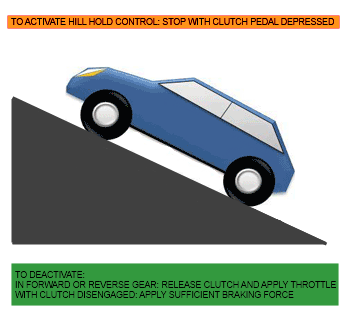When starting a vehicle from a stationary position on a steep incline, a driver has to coordinate the application and release of the clutch, brake and accelerator pedals in a manual transmission car. This scenario can be both frustrating and unsafe. Hill hold control systems assist the driver in these situations by keeping the brakes applied until torque from the engine is applied to wheels. Depending on the manufacturer, hill hold control may also be referred to as hill-start assist or hill-start control.
Most hill-hold systems used in vehicles today can be placed into one of three categories.
Basic-Level System:
The sensors used in the most basic hill-hold systems are the brake pedal travel sensor, master cylinder pressure sensor, wheel speed sensors and throttle position sensor. Hill hold takes place after the vehicle comes to a complete stop with the driver’s foot on the brake, determined by the brake pedal travel sensor. The required braking force to be applied for the hill hold function is calculated based on the amount of force required to keep the vehicle stationary. The braking force applied is a function of the pressure applied to the brakes, which is determined by the master cylinder pressure sensor. When the brake pedal is released, Hill Hold Control is activated, maintaining the appropriate brake pressure until the throttle is applied.
The limitation of the basic-level system is that it’s independent of the gradient of the incline. Therefore, if the conditions required to activate Hill Hold Control (entrance criteria) are satisfied, then the system will be activated whether the surface has a positive, negative or zero gradient. The ‘exit criteria’ of the system is based only on throttle position.
Medium-Level System
These systems are more complex than basic systems. The sensors used in these systems are the same as the sensors used by the basic-level systems plus a clutch position switch (for manual transmission vehicles), a longitudinal acceleration sensor and a sensor indicating when the vehicle is in reverse gear.
The entrance criteria of a mid-level system are different when
the vehicle is on an incline and when it’s on a decline. In the case where a
vehicle is on an incline, three conditions must be satisfied:
- The vehicle must come to a complete stop;
- The incline must be sufficiently steep to require the use of hill
hold control as determined by the longitudinal acceleration sensor;
- The clutch must be completely depressed or close to full travel (manual transmissions only).
When on a decline, an additional condition is required. The reverse gear must be engaged.
This indicates to the system that the driver is trying to back up a hill without rolling forward.
The exit criteria or deactivation of hill hold control is based on either of two independent conditions.
The first is an indication that the driver wants to move the vehicle. This may be indicated by the following:
- The clutch pedal being released to the point of gear engagement (which is detected by the second clutch switch);
- An appropriate amount of throttle being applied for the vehicle to start moving (a higher amount of throttle must be applied when the vehicle is moving up a steeper incline).
The second is the brake being applied in any of the following conditions:
- When the vehicle is stopped on a positive incline and the clutch is released (indicating neutral is engaged);
- The clutch is pressed and reverse gear is engaged while the vehicle is stopped on an incline;
- The vehicle is stopped on a decline and the clutch is released.
If the brake is applied in any of the above conditions, it means that the driver wants to let the vehicle roll in the direction of the slope. Hill hold control is deactivated by reducing the torque applied to the wheels to stop the car at a rate proportional to the slope. This gives the mid-level system a more natural feel.
Up-Level System
The up-level system is similar to the mid-level system, except that it has these extra features:
- A clutch travel sensor for determining the speed with which the clutch pedal is pressed or released
(to allow the system to apply and release the brakes accordingly);
- An additional hill-descent feature that enables the system to reverse the vehicle when going downhill.
Different manufacturers implement hill hold in different ways.
For example, the system described in the images on this page is employed by Delphi.
Bosch has an electronic control that activates the brakes for 2 seconds to give the driver time to start the vehicle.





